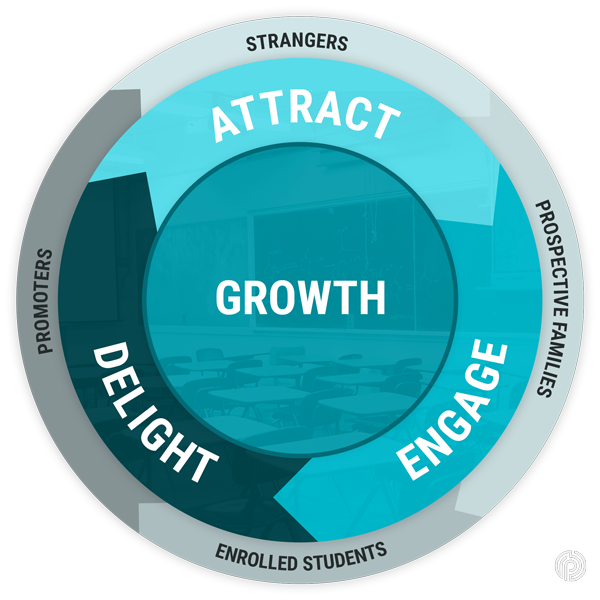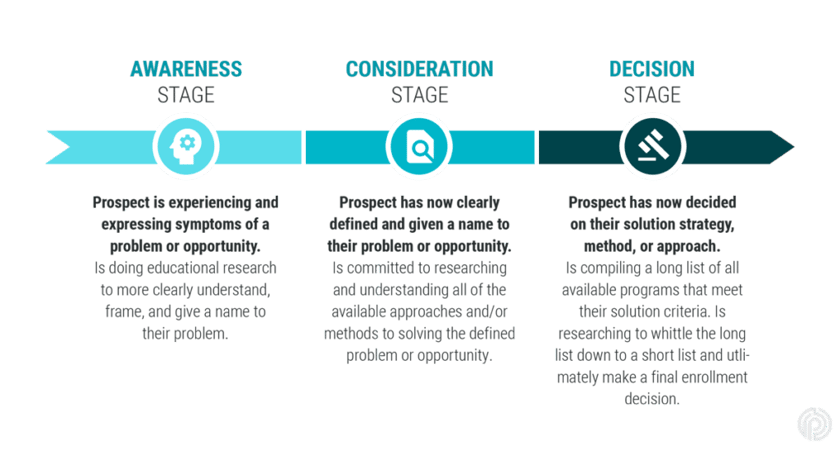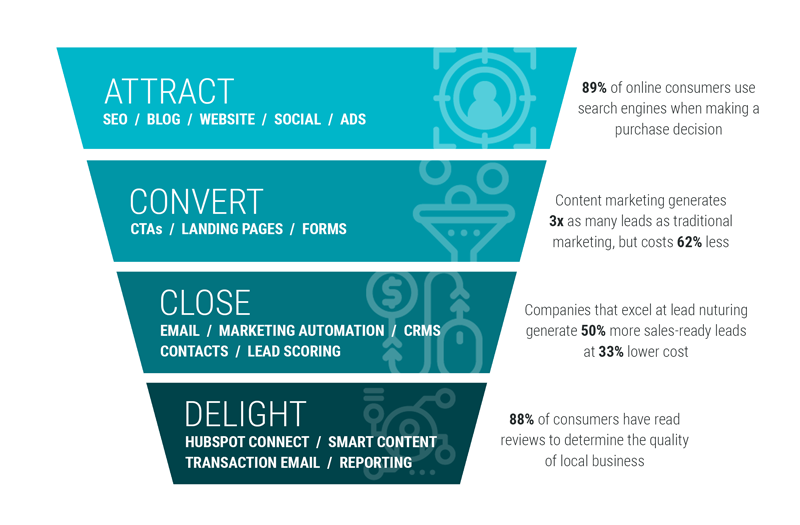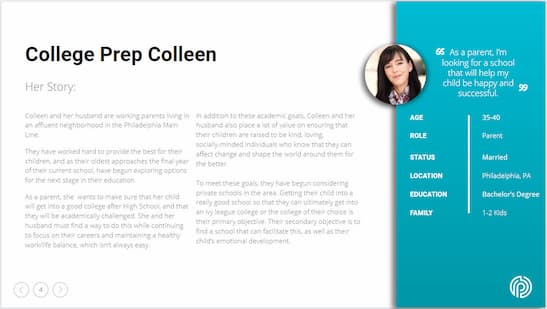

Inbound Enrollment is a methodology to help colleges, universities, and independent K12 schools improve their admissions and enrollment funnel to fill seats. It builds upon the concepts of inbound marketing, tailored to the unique journey that parents and students go on when making a decision about their education. Content marketing, email marketing, social media, and lead nurturing all play a critical role in the process.
What is the Inbound Enrollment Methodology?
The Inbound Enrollment Methodology is an approach to marketing and admissions that allows you to meet your goals by building meaningful, lasting relationships online. It includes tactics that enable you to attract the right audience to your website, convert them into known contacts within your database, and engage with them at key moments in their journey so that they take that next step to learn more about your institution and, ultimately, apply. Once they are enrolled students (or parents of enrolled students), inbound enrollment is about providing an online experience that delights them in an effort to retain them.
The inbound enrollment methodology can be applied in three ways:
- Attract: drawing in the right prospective learners and their families to your website with valuable content and conversations that establish you as a trusted advisor with whom they want to engage.
- Engage: presenting insights and solutions that align with their pain points and goals so they are more likely to inquire, apply and visit your school, college or university.
- Delight: providing help and support to empower your newly enrolled learners and their families find success with their decision to select your institution.

The entire methodology requires that you have a comprehensive understanding of who your ideal student is, as well as the challenges they face, the goals they aspire to reach, and the various ways in which they seek to educate themselves along their journey.

Why should you adopt an Inbound approach for your school or institution?
If you support Admissions and Enrollment at your institution then you know that the way people make decisions about their education has changed dramatically over the years.
In the past, colleges, universities, and private schools had a great deal of control over how a potential student or family learned about their organization. School fairs, college fairs, direct mailings, print and radio advertisements, lawn signs, bill boards—these traditional outbound channels allowed educational institutions to control the message that potential students were hearing about the institution.
All of this changed with the emergence of the internet.
Social media and review sites allow students and families to share opinions about different schools, and search engines like Google allow them to conduct their own research into a school or program. This means that by the time an enrollment or admissions professional actually interacts with a prospect, there’s a very good chance that that prospect has already formed a strong opinion about your institution.
If it’s a positive opinion, great: That works in your favor. But if it’s a negative opinion, that obviously works against you.
Clearly, it’s in the best interest of your institution to own your online presence as much as possible. While the outbound channels listed above are still an important piece of the enrollment puzzle and deserving of your attention and resources, so, too, are the inbound channels than prospects take to learn about your school.
How is it different from Inbound Marketing?
If you’re familiar with inbound marketing, then you’re probably thinking that inbound enrollment sounds a lot like it, and for good reason: Inbound enrollment is based on the inbound marketing methodology.
There are some important differences, though, which warrant review.
First and foremost, whereas the inbound marketing methodology can theoretically be picked up by any organization and put into action, inbound enrollment is designed specifically for marketers working in education. It acknowledges the unique steps in the enrollment funnel, as well as the challenges that you face which marketers in other industries don’t have to worry about.
Recommended Reading: 11 Reasons Schools Should Use HubSpot
Another key difference is that inbound enrollment is heavily focused on local marketing so that you can be sure the people visiting your website (and converting on your content) are local individuals who might actually enroll in your school or program. Online programs might, admittedly, target more nationally competitive terms.
And finally, inbound enrollment acknowledged that positive word of mouth is one of the primary channels through which schools grow their funnel. It aims to complement those efforts, rather than work in a silo, so that you can realize even more ROI from that most valuable source of interest.
Inbound Enrollment Strategies
Your school’s inbound enrollment strategies will ultimately fall into three broad buckets—attract, engage, delight—which should be leveraged in all of your enrollment activities, from recruitment to admissions to retention and advancement.

Attracting Good-Fit Students and Families
In order to attract mission-appropriate students and families to your school or university, you need to create content that provides value to those individuals and helps them solve a problem they are facing.
What this content looks like will depend heavily on the type of student or family you are trying to attract (i.e., your personas).
Typically, an effective content strategy will involve:
- Blogging: Blog posts give you the opportunity to answer the kinds of questions that your prospective students and families might have, which aren’t directly related to your school. This helps you provide value and build trust with your ideal audience and gives you content that you can leverage throughout your marketing efforts.
- Content Offers: Ebooks, checklists, calculators, and other gated content offers give you the opportunity to provide even more value to the visitors to your website, while offering a path to convert anonymous visitors into known contacts within your database which you can market to.
- Landing Pages: These are the pages on your website specifically designed to encourage your visitors to take an action and convert. They must be thoughtfully designed and optimized to remove distractions and friction and encourage your visitors to take the next step.
- Your Website: Your website needs to communicate and reinforce the value that your college or school offers to enrolled students. It needs to answer the questions that an individual may have about your school or program. It needs to include all of the pages that someone would expect to find.
- Social Media Posts: Social media is a critical inbound channel for most schools, and a great way of promoting your content.
- Proof Points: Data, statistics, and testimonials that speak to the value of your school are an essential piece of building trust with your website visitors.
Of course, each of these various pieces of content should be created with search engine optimization (SEO) in mind so that your site can rank for those keywords that your audience is actually using as they conduct research online. Without an effective SEO strategy, it’s possible that no one will be able to discover the content you create.
Engaging Inquiries and Applicants
Once you have attracted visitors to your website and converted them into known contacts in your database, you need to engage with them so as to nurture them further down your enrollment funnel.
Any form of communication with an inquiry or applicant is another opportunity for you to provide value and build trust. This can include telephone outreach, email marketing, social media marketing, and the use of chatbots on your website, and any other form of outreach or communication. Tailoring these messages so that they speak to each inquiry or applicant where they are at that exact moment in their journey will be essential to your success.
Delighting Enrolled Students, Alumni, and the Broader Community
By delighting your existing students, you ensure that they remain happy and satisfied even after they’ve enrolled, improving your ability to retain them and reducing the possibility that they might transfer elsewhere.
Similarly, by delighting your alumni and the broader community, you will build relationships which can funnel more inquiries and applicants to your school through word-of-mouth and other types of referrals—historically a source of the highest quality inquiries that most schools receive.
Additionally, delight is a crucial step in advancement and fundraising, particularly amongst alumni and donors.
The Proven Methodology For Growing Your School’s Enrollment Funnel
There’s little doubt that the way in which people make decisions has changed over the past few years. This is true whether someone is looking to try a new restaurant, buy a new car, transfer to a new school, or enroll in college.
By following the inbound enrollment methodology and embracing technology that empowers you to implement all of the various pieces of the enrollment puzzle, you can modernize your institution’s enrollment and admissions processes to meet the demands and expectations of today’s students and families.
At Pepperland, we’ve got years of experience helping schools and universities pivot to the inbound methodology, and an expertise in implementing technologies like HubSpot that can support you every step of the way.
Using the Inbound Methodology in Higher Education
Most colleges and universities will have at least some level of built-in demand for their programs.
More often than not, this will be in the form of local high school graduates who understand that they need to go to college and earn a bachelor’s degree in order to have a successful career. For them, it’s the expected next step after high school; while they might need information about individual programs and information about your specific institution, they don’t need to be convinced about the value of earning a degree.

Other types of programs, however, will have less built-in demand. These programs can realize tremendous value by pursuing the inbound methodology. While the exact strategy that you follow will depend on your unique goals, requirements, and other factors, the scenario below serves as an illustrative example of what inbound enrollment might look like at your college or university
Consider an institution that offers graduate degrees, professional degrees, certificates, or a bachelor’s completion program. In each of these cases, there is no built-in, assumed demand as there is with a traditional undergraduate degree program. Such programs will sink or swim based on their ability to attract right-fit applicants who ultimately enroll.
The first step in applying the inbound methodology is to understand what this right-fit student looks like by creating a student persona. This process will help you discover the motivations that lead potential students to seek a degree. In the case of a graduate degree program, you will probably discover that your students enroll after they realize that they must have an advanced degree in order to hold a certain job title or work in a particular career.

Using this insight, your goal would then be to create content in the form of blog posts that answers questions they have early in their search. You might, for example, write blog posts about things like:
- The job demand and salary for certain job titles
- The education required for working in a certain industry
- The necessary skills for a particular job
- The typical career path leading to a certain job title
- Etc.
Your goal in writing this content isn’t to convince the person to apply to your institution, but to provide value and begin developing trust by answering their questions.
Once they are on your website reading a blog post, the reader might see a call-to-action prompting them to visit a landing page, where they are offered a career guide, checklist, or some other tool in exchange for their contact information.
At the point they give you their contact information, they are in your funnel, and you can begin educating them through email about the different programs you offer and how these programs align with their goals. While you continue to provide value, you are also nurturing them along towards another conversion opportunity: Attending an info session or open house where they can have their most pressing questions answered and, finally, towards submitting an application.
As you can see, content plays a variety of roles throughout this entire journey, in the form of blog posts, website pages, program pages, calls-to-action, landing pages, email, etc. Using the right tools can empower you to reach all of these goals in a streamlined and efficient manner. For example, we typically recommend using a tool like HubSpot, which can power everything mentioned above while also fulfilling the needs of members of your admissions team.
It’s important to note that this isn’t in place of other, typically outbound strategies that colleges have traditionally pursued, such as participating in college fairs, sending out flyers, or advertising on the radio and television. Inbound is meant to be done in concert with these other tactics so that you can be sure you are meeting potential students no matter where they are in their journey.
Using the Inbound Methodology in K12
Independent K12 schools are unique in many ways when compared to public schools. One important way is the way in which seats get filled. While public schools are supported by state and local taxes and filled by their districts, independent schools are responsible for funding themselves. This is typically done by attracting mission-appropriate families that are willing to pay tuition for the unique value that such a school offers (Tuition is also often supplemented by donations.)
To fulfill this need, as a member of the admissions or communications team, your day is largely spent finding new ways of attracting inquiries and applicants into your funnel. If your school is like most, this is primarily done through outbound methods:
- School fairs
- Television, radio, and billboard advertisement
- Flyers and posters in places that parents frequent
- Etc.
While these methods undoubtedly still work, they can be supported through by embracing an inbound strategy as well.
Recommended Reading: How to Host a Virtual Open House for Your School
As with a higher education institution, this all starts by first having a firm understanding of your school’s unique value proposition compared to its competitors, as well as an understanding of your student and parent personas. By understanding what a mission-appropriate family looks like for your school, you are better equipped to understand the challenges they are facing, and the goals they are trying to achieve, which may ultimately lead them to consider enrolling in your school.

Upon developing your personas, you are likely to compile a list of questions which your personas commonly ask. These questions can and should inform your content strategy.
For example, a private Catholic school may find that prospective parents commonly ask questions like:
- What’s the difference between a Catholic school and a public school?
- Are Catholic schools more expensive than public schools?
- Does my family need to be religious for my child to attend a Catholic school?
- Etc.
Using this insight, you might choose to start a blog on your school’s website, where you will answer each of these questions (and more) in the form of SEO-friendly blog posts. Your goal in writing this content is simply to answer the reader’s question so that you can provide value and begin building trust—not to promote your school.
You might also choose to promote your content through social ads (on Facebook and Instagram), targeting families that match your persona.
Once the parent is on your website consuming your content, they might then see a call-to-action of some kind that prompts them to visit a landing page, where they can download some form of free content (often in the form of an ebook or checklist) in exchange for their contact information. By giving you their contact information, they enter your sales funnel, where you can begin to nurture them through email.
Exactly what step you are nurturing them towards taking will depend on your institution. Commonly, the next step will be to sign up for a virtual or in-person open house, where you can answer their questions and highlight your faculty, your facilities, and the unique value offered by your school. After they have attended an open house, you would then continue to nurture them towards applying to your school and, finally, enrolling.
Inbound isn’t just about Admissions. It helps with Retention too.
Of course, one of the greatest benefits of inbound enrollment is exactly what we just discussed: Its ability to attract potential students and families to your website and convert them into leads and, eventually, paying students.
But inbound doesn’t only fill seats; it can keep them filled, too.
It does this largely in the same way as it does in the earlier stages of the buyer’s journey: By providing value. The only difference is that instead of providing value to prospective students and families, you are providing value to the existing members of your community.
For example, a college or university might create content designed to help new students have a successful first year, reducing the risk that they will drop out or transfer to a different college. As the student progresses towards earning the degree, the university would continue to provide value by answering the questions they have each step of the way: advice and tips for choosing a major, lining up an internship, and even how to prepare for a job interview.
A private K-12 school, on the other hand, might provide resources to parents at key junctures, such as the transition from elementary to middle school, middle to high school, or high school to college.
What content can you create to continuously provide value to your existing students? What email sequences can you build to keep your community active and engaged? What resources can your student advisors or career coaches provide so that students feel valued?
The same concept applies to Advancement. Is there content that you can create to keep your alumni engaged with your school? Can you tailor a weekly or monthly newsletter to their specific personal interests? How are you laying the foundation for future donations from your community?
Learn More About Inbound Enrollment
Think your institution is ready to embrace the inbound methodology and overhaul its enrollment process? Have questions about what this looks like in action? Curious about how a tool like HubSpot can help you improve your enrollment goals? Overwhelmed by everything involved?
Request a free consultation to learn more about inbound enrollment and the role that Pepperland can play in helping you reach your goals.
Contact Us
120 Elm St
Cheshire, CT, USA
Hours (EST):
Monday to Friday: 9:00 to 5:00 pm
Saturday: closed
Sunday: closed
Copyright 2025 Pepperland Marketing, LLC. All rights reserved.
